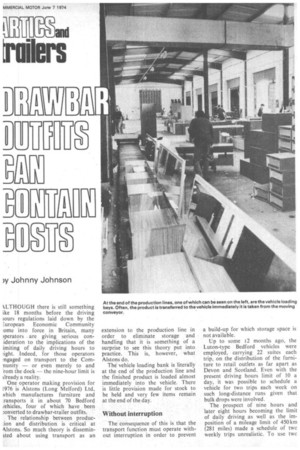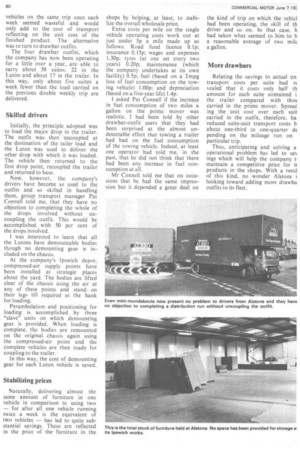)y Johnny Johnson
Page 81

Page 82

If you've noticed an error in this article please click here to report it so we can fix it.
kLTHOUGH there is still something ike 18 months before the driving tours regulations laid down by the European Economic Community :ome into force in Britain, many Terators are giving serious conideration to the implications of the imiting of daily driving hours to :ight. Indeed, for those operators !ngaged on transport to the Cornnunity — or even merely to and rom the dock — the nine-hour limit is tlready a reality.
One operator making provision for 1976 is Alstons (Long Melford) Ltd, which manufactures furniture and .ransports it in about 70 Bedford vehicles, four of which have been onverted to drawbar-trailer outfits. The relationship between produc:ion and distribution is critical at Alstons. So much theory is disseminlied about using transport as an extension to the production line in order to eliminate storage and handling that it is something of a surprise to see this theory put into practice. This is, however, what Alstons do.
The vehicle loading bank is literally at the end of the production line and the finished product is loaded almost immediately into the vehicle. There is little provision made for stock to be held and very few items remain at the end of the day.
Without interruption
The consequence of this is that the transport function must operate without interruption in order to prevent a build-up for which storage space is not available.
Up to some 12 months ago, the Luton-type Bedford vehicles were employed, carrying 22 suites each trip, on the distribution of the furniture to retail outlets as far apart as Devon and Scotland. Even with the present driving hours limit of 10 a day, it was possible to schedule a vehicle for two trips each week on such long-distance runs given that bulk drops were involved.
The prospect of nine hours and later eight hours becoming the limit of daily driving as well as the imposition of a mileage limit of 450 km (281 miles) made a schedule of two weekly trips unrealistic. To use two vehicles on the same trip once each week seemed wasteful and would only add to the cost of transport reflecting on the unit cost of the finished product. The alternative was to turn to drawbar outfits.
The four drawbar outfits, which the company has now been operating for a little over a year, are able to carry about 39 suites; 22 in the Luton and about 17 in the trailer. In this way, only about five suites a week fewer than the load carried on the previous double weekly trip are delivered.
Skilled drivers
Initially, the principle adopted was to load the major drop in the trailer. The outfit was then uncoupled at the destination of the tailer load and the Luton was used to deliver the other drop with which it was loaded. The vehicle then returned to the first drop point, recoupled the trailer and returned to base.
Now, however, the company's drivers have become so used to the outfits and so skilled in handling them, group transport manager Pat Connell told me, that they have no objection to completing the whole of the drops involved without uncoupling the outfit. This would be accomplished with 50 per cent of the drops involved.
I was interested to learn that all the Lutons have demountable bodies though no demounting gear is included on the chassis.
At the company's Ipswich depot, compressed-air supply points have been installed at strategic places about the yard. The bodies are lifted clear of the chassis using the air at any of these points and stand. on their legs till required at the bank for loading.
Perambulation and positioning for loading is accomplished by three "slave" units on which demounting gear is provided. When loading is complete, the bodies are remounted on the original chassis again using the compressed-air point and the complete vehicles are then ready for coupling to the trailer.
In this way, the cost of demounting gear for each Luton vehicle is saved.
Stabilizing prices
Naturally, delivering almost the same amount of furniture in one vehicle in comparison to using two — for after all one vehicle running twice a week is the equivalent of two vehicles — has led to quite substantial savings. These are reflected in the price of the furniture in the shops by helping, at least, to stabilize the overall wholesale price.
Extra costs per mile on the single vehicle operating costs work out at just under 5p a mile made up as follows: Road fund licence 0.1p; insurance 0.15p; wages and expenses I .30p; tyres (at one set every two years) 0.20p; maintenance (which the company undertakes at its own facility) 0.5p; fuel (based on a 2 mpg loss of fuel consumption on the towing vehicle) 1.00p; and depreciation (based on a five-year life) 1.4p.
I asked Pat Connell if the increase in fuel consumption of two miles a gallon on the prime mover was realistic. I had been told by other drawbar-outfit users that they had been surprised at the almost undetectable effect that towing a trailer had had on the fuel consumption of the towing vehicle. Indeed, at least one operator had told me, in the past, that he did not think that there had been any increase in fuel consumption at all.
Mr Connell told me that on occasions that he had the same impression but it depended a great deal on the kind of trip on which the vehicl had been operating, the skill of th driver and so on. In that case, h had taken what seemed to him to h a reasonable average of two mile a gallon.
More drawbars
Relating the savings to actual un transport costs per suite had re vealed that it costs only half th amount for each suite contained i the trailer compared with thos carried in the prime mover. Spread ing the •unit cost over each suit carried in the outfit, therefore, ha reduced suite-unit transport costs b about one-third to one-quarter de pending on the mileage run on particular trip.
Thus, anticipating and solving a operational problem has led to sav ings which will help the company t. maintain a competitive price for it products in the shops. With a resul of this kind, no wonder Alstons i looking toward adding more drawba outfits to its fleet.




























































































































































